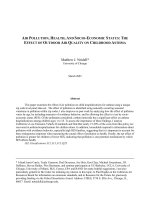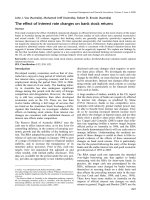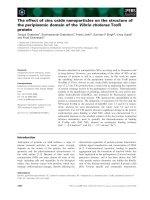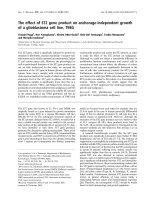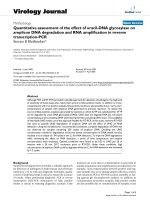The effect of non verbal communication on interpersonal communications
Bạn đang xem bản rút gọn của tài liệu. Xem và tải ngay bản đầy đủ của tài liệu tại đây (1.6 MB, 65 trang )
BỘ GIÁO DỤC VÀ ĐÀO TẠO
TRƯỜNG ĐẠI HỌC DÂN LẬP HẢI PHÒNG
-------------------------------
ISO 9001:2015
KHÓA LUẬN TỐT NGHIỆP
NGÀNH: NGÔN NGỮ ANH
Sinh viên
: TRẦN THỊ LIÊN
Giảng viên hướng dẫn: THS. PHẠM THỊ THÚY
HẢI PHÒNG - 2018
BỘ GIÁO DỤC VÀ ĐÀO TẠO
TRƯỜNG ĐẠI HỌC DÂN LẬP HẢI PHÒNG
-----------------------------------
THE EFFECTS OF NON-VERBAL COMMUNICATION ON
INTERPERSONAL COMMUNICATIONS
KHÓA LUẬN TỐT NGHIỆP ĐẠI HỌC HỆ CHÍNH QUY
NGÀNH: NGÔN NGỮ ANH
Sinh viên
:TRẦN THỊ LIÊN
Giảng viên hướng dẫn:THS. PHẠM THỊ THÚY
HẢI PHÒNG - 2018
BỘ GIÁO DỤC VÀ ĐÀO TẠO
TRƯỜNG ĐẠI HỌC DÂN LẬP HẢI PHÒNG
--------------------------------------
NHIỆM VỤ ĐỀ TÀI TỐT NGHIỆP
Sinh viên: Trần Thị Liên
Mã SV: 1412751102
Lớp: NA1801
Ngành: Ngôn Ngữ Anh
Tên đề tài:
The effect of non-verbal communication on interpersonal
communications.
NHIỆM VỤ ĐỀ TÀI
1. Nội dung và các yêu cầu cần giải quyết trong nhiệm vụ đề tài tốt nghiệp
( về lý luận, thực tiễn, các số liệu cần tính toán và các bản vẽ).
……………………………………………………………………………..
……………………………………………………………………………..
……………………………………………………………………………..
……………………………………………………………………………..
……………………………………………………………………………..
……………………………………………………………………………..
……………………………………………………………………………..
……………………………………………………………………………..
2. Các số liệu cần thiết để thiết kế, tính toán.
……………………………………………………………………………..
……………………………………………………………………………..
……………………………………………………………………………..
……………………………………………………………………………..
……………………………………………………………………………..
……………………………………………………………………………..
……………………………………………………………………………..
……………………………………………………………………………..
……………………………………………………………………………..
3. Địa điểm thực tập tốt nghiệp.
……………………………………………………………………………..
……………………………………………………………………………..
……………………………………………………………………………..
CÁN BỘ HƯỚNG DẪN ĐỀ TÀI TỐT NGHIỆP
Người hướng dẫn thứ nhất:
Họ và tên:.............................................................................................
Học hàm, học vị:........................................................................ ...........
Cơ quan công tác:.................................................................................
Nội dung hướng dẫn:............................................................................
Người hướng dẫn thứ hai:
Họ và tên:.............................................................................................
Học hàm, học vị:...................................................................................
Cơ quan công tác:.................................................................................
Nội dung hướng dẫn:............................................................................
Đề tài tốt nghiệp được giao ngày
tháng
năm
Yêu cầu phải hoàn thành xong trước ngày
tháng
Đã nhận nhiệm vụ ĐTTN
Đã giao nhiệm vụ ĐTTN
Sinh viên
năm
Người hướng dẫn
Hải Phòng, ngày ...... tháng........năm 2018
Hiệu trưởng
GS.TS.NGƯT Trần Hữu Nghị
PHẦN NHẬN XÉT CỦA CÁN BỘ HƯỚNG DẪN
1. Tinh thần thái độ của sinh viên trong quá trình làm đề tài tốt nghiệp:
……………………………………………………………………………..
……………………………………………………………………………..
……………………………………………………………………………..
……………………………………………………………………………..
……………………………………………………………………………..
……………………………………………………………………………..
……………………………………………………………………………..
2. Đánh giá chất lượng của khóa luận (so với nội dung yêu cầu đã đề ra
trong nhiệm vụ Đ.T. T.N trên các mặt lý luận, thực tiễn, tính toán số
liệu…):
……………………………………………………………………………..
……………………………………………………………………………..
……………………………………………………………………………..
……………………………………………………………………………..
……………………………………………………………………………..
……………………………………………………………………………..
……………………………………………………………………………..
……………………………………………………………………………..
……………………………………………………………………………..
3. Cho điểm của cán bộ hướng dẫn (ghi bằng cả số và chữ):
……………………………………………………………………………..
……………………………………………………………………………..
……………………………………………………………………………..
Hải Phòng, ngày … tháng … năm
Cán bộ hướng dẫn
(Ký và ghi rõ họ tên)
THS.Phạm Thị Thúy
ACKNOWLEDGEMENTS
I would like to express my deepest gratitude to many people who have
assisted me in the completion of my research .
Firstly , I am so grateful to Ms. Pham Thi Thuy (MA) my supervisor
for her guidance and precious comments throughout this study. She has
helped me so much in choosing the title of this study and giving me
valuable suggestions, advice and detailed comments about my study .
Secondly, I want to send my sincere thanks to all the teachers of
Foreign Language Department at Hai Phong Private University for their
precious and useful lessons during my four-year study. Especially, I am
profoundly grateful to Ms. Nguyen Thi To Hoan , M.A, my lecturer of the
subject Cross - cultural Communication who has inspired me and provided
me the foundation knowledge in order that I can base on to build my
graduation paper .
Last, but far from least, I would like to thank my parents and my
friends for their encouragements and valuable advice.
Hai Phong , July 2018.
Tran Thi Lien
LIST OF ABBREVIATIONS
HPU: Haiphong Private University
NVC : Nonverbal communication
TABLE OF CONTENTS
PART I: INTRODUCTION ............................................................................. 1
1. Rationale ......................................................................................................... 1
2. Aims of the study ............................................................................................ 1
3. Scope of the study ........................................................................................... 2
4. Methods of the study: ...................................................................................... 2
5. Significance of the study ................................................................................. 2
6. Design of the study: ......................................................................................... 3
PART II: DEVELOPMENT............................................................................. 4
CHAPTER 1: LITERATURE REVIEW ........................................................ 4
1.1 Communication: ............................................................................................ 4
1.2 Verbal communication .................................................................................. 6
1.2.1 What is verbal communication? ................................................................. 6
1.2.2 Types of verbal ........................................................................................... 6
1.3
Nonverbal communication ......................................................................... 8
1.3.1 What is nonverbal communication? ........................................................... 8
1.3.2 Types of Nonverbal Communication .......................................................... 9
1.3.2.1 Facial Expressions ................................................................................... 9
1.3.2.3. Voice (Paralinguistic) ........................................................................... 11
1.3.2.4. Body movement and Posture ................................................................ 11
1.3.2.5. Space .................................................................................................... 12
1.3.2.6. Eye contact ........................................................................................... 14
1.4
Interpersonal communication ................................................................... 15
1.4.1 Defining interpersonal communication .................................................... 15
1.4.2 The characteristics of interpersonal communication................................. 16
1.5 The effect of nonverbal on interpersonal communication ........................... 17
1.6 The effect of hand gestures on interpersonal communictation .................... 23
1.7 The role of nonverbal on interpersonal communications ............................. 32
CHAPTER 2: THE STUDY ON THE EFFECT OF NON-VERBAL
COMMUNICATION ON INTERPERSONAL COMMUNICATIONS ..... 39
1. The reality of learning and teaching English-speaking skill at Hai Phong
Private University .............................................................................................. 39
1.1. The teaching staff: ...................................................................................... 39
1.2 The researcher ............................................................................................. 39
1.3 The students................................................................................................. 39
1.4 English teaching and learning condition at Hai Phong Private University. . 40
2. The survey questionnaires ............................................................................. 40
2.1. The design of the survey questionnaires ..................................................... 40
2.2. The data analysis ........................................................................................ 42
2.2.1 The result on the students’ English learning time ..................................... 42
2.2.2 Result on Students’ attitude toward learning nonverbal communication
skills .................................................................................................................. 42
2.2.3 The result on the student perceived importance of nonverbal
communication .................................................................................................. 43
2.2.4 The result on the student' frequency of using nonverbal communication . 44
2.2.5. The result from students’ opinions on the effects of nonverbal
communication on interpersonal communications ............................................ 44
2.2.6 The result on students' frequency of using hand gestures ......................... 45
2.2.7. The result from students’ opinions on the effects of using hand gestures
during communicating ....................................................................................... 46
2.2.8 The result from students’ expectations on the more nonverbal
communication techniques ............................................................................... 47
CHAPTER 3 : FINDING AND DISCUSSION ............................................. 48
PART 3: CONCLUSION ................................................................................ 49
REFERENCES ................................................................................................ 50
APPENDIX A: QUESTIONNAIRE FOR STUDENTS ............................... 52
PART I: INTRODUCTION
The current study begins with this introductory part, which describes the
rationale to the study and presents the aims and the research questions. It also
discusses the scope of the study, the method, the significance of the study and
provides an overview of the study.
1. Rationale
Nowadays, with the development of the international relationship among
countries, learning communication especially learning how to use nonverbal
communication plays a more and more important role during speaking. People
use nonverbal communication for discussion in many forums and in different
aspects of life. In Vietnam, nonverbal communication is also very essential for
study and work place. Thus, learning nonverbal communication has become
more important than ever.
However, there are still some problems today about the teaching and learning
nonverbal communication , particularly at Hai Phong Private University (HPU).
In addition, the majority of the first year English majors are really passive in
their nonverbal communication . Furthermore, they feel reluctant to get involved
in the nonverbal communication activities in the lessons even they can
understand and practice them. Therefore, their nonverbal communication skill
is often low and very few of them can use nonverbal communication.
In order to help the students at HPU, especially the first year English majors at
HPU improve their nonverbal communication skill, the author of the study
carries on this study with the title: “THE EFFECTS OF NON-VERBAL
COMMUNICATION ON INTERPERSONAL COMMUNICATIONS".
The study is expected to help the students of Foreign Languages Department at
HPU, especially the first year English majors at HPU improve their nonverbal
communication in order to get a better communicative skill.
2. Aims of the study
The aim of this study is applying techniques for students to improve their
nonverbal communication. Besides, this is also a way to help both the teacher
and students love nonverbal communication more and get higher effectiveness
in communication. The author wants to change the students’ attitude on
1
nonverbal communication and let them find nonverbal communication more
interesting.
The expectation is that the first year English majors at HPU can consider
nonverbal communication as their favorite activity. To reach the aims set
above, our research question for this study is as follow:
To what extent do the nonverbal communications help interpersonal
communcation?
3. Scope of the study
The present study focuses on improving the first year English majors’ nonverbal
communication at HPU. In fact, there are lots of various techniques to study
nonverbal communication. It requires much of time and effort. However, due to
the limitation of time, resources and knowledge of mine as well as some other
conditions, the researcher conducted an action plan with the application of
techniques, which include some effective methods to help the English majors at
HPU enrich their nonverbal communication. Thus, the result of study is limited
only to those students participating in this study and these findings may impact
the generalization to the larger population of all students and they can also be
the references for anyone who wants to have a better nonverbal communication .
4. Methods of the study:
To complete this study, a variety of methods have been employed:
- Concemed materials including reference books on teaching methodology have
been carefully studied and analyzed.
- A survey questionnaire was conducted to the first year English majors at HPU
to gather information and evidence for the study.
All the comments, remarks, recommendations and conclusion provided in the
study were based on the data analysis of the study.
5. Significance of the study
This study holds significance for several reasons. Initially, the study is
undertaken to determine whether the applying nonverbal communication can
have positive effect on students’ communication skill. Secondly, the techniques
also help students learn more about nonverbal communicationand change
students’ attitudes toward nonverbal communication. Finally, the results of the
2
study provide evidence and necessity to implement the techniques in learning
and teaching English at HPU.
6. Design of the study:
To describe the study clearly and understand it deeply about the effect of
nonverbal communication on interpersonal communication especially hand
gesture , my paper is performed by 3 parts:
Part one is an introduction which includes rationale, aims, scope, methods,
significance and design of the study.
Part two is the development and also the most important
part.
Development part has three main chapters:
-Chapter 1 : In this chapter, the researcher introduces the theory of
communication, verbal communication, nonverbal communication, interpersonal
communications and gestures, the effect of non-verbal communication on
interpersonal communications
- Chapter two: The study on the effect of non-verbal communication on
interpersonal communications, the reality of learning and teaching English
speaking skill at Hai Phong Private University: the teaching staff, the students,
English teaching and learning condition at Hai Phong Private University ,the
survey questionnaires, the design of the survey questionnaires, the data analysis,
the result on students’ learning time, t he result on the students’ attitude toward
nonverbal communication, the result on the students’ perceived importance of
nonverbal communication, the result on students’ frequency of using nonverbal
communication in class time, the result on students’ opinions on the effects of
nonverbal communication on interpersonal communications, the result on
students’ frequency of using hand gestures , the result from students’ opinions
on the effects of using hand gestures during communicating, the result from
students’ expectations on the more nonverbal communication techniques
- Chapter 3 : Finding and discussion
Part three is the conclusion that summarizes the content of the paper
My graduation has been done in difficult condition so there must be
unavoidable mistakes. However, I hope that it would appear to be necessary
material to help students of English like me perfect the knowledge of nonverbal
communication.
3
PART II: DEVELOPMENT
CHAPTER 1: LITERATURE REVIEW
1.1 Communication:
Definitions of communication have been taken a lot of attention and
concern from different researchers. There are several definitions on
communications
presented
in
language
learning
methodology.
The
communication consists in the transmission of a message through a channel (the
air, cell phone, printed or audiovisual media), between an issuing entity and
another receiver.
The key to effective communication is that the process is successful, that is,
that the message is transmitted and understood clearly by the recipient, without
misinterpretation or omission of information.
Language (verbal, written or gestural), in any of its forms, is the most
common mechanism to transmit ideas between two or more people.
All communications, intentional or not, have some kind of repercussion in
the receiver of the information. If the message is understood in its entirety, the
effect is usually the desired one.
Communication is a complex process oriented towards the action of
informing, generating the understanding in the counterpart and inducing some
type of response on the part of the receiver.
Those versed in communication have a fairly broad perception of the
subject, based on their experience. Five definitions of communication are
presented by some experts in the field:
Alberto Martínez de Velasco and Abraham Nosnik
" Communication can be defined as a process by means of which a person
is in contact with another through a message, and expects the latter of a
response, be an opinion, activity or behavior "-Alberto Martínez.
4
" In other words, communication is a way to establish contact with others
through ideas, facts, thoughts and behaviors, looking for a reaction to the
statement that has been sent "- Abraham Nosnik.
According to both Mexican authors, the intention of the issuer is to modify
or reinforce the behavior of the person receiving the communication. That is, the
act of communicating is carried out to receive something in return.
Fernando González Rey
"It is a process of social interaction, through signs and sign systems,
product of human activities. Men in the communication process express their
needs, aspirations, criteria, emotions, etc."
María del Socorro Fonseca
" To communicate is to come to share something of ourselves. It is a
specific rational and emotional quality of man that arises from the need to get in
touch with others, exchanging ideas that acquire meaning or meaning according
to common previous experiences”
It is very difficult to define the term ‘Communication` in a simple way.
Different scholars defined communication in different ways. The simplest
definition of communication is “a process of sending and receiving a message
between two parties.” Actually, communication is the process of transferring
information and understanding from one of more people one or more people. In
the most clear from, communication means interaction between two parties.
Communication can occur via various processes and methods and
depending on the channel used and the style of communication there can be
various types of communication. Here, only based on the channels used for
communicating, the process of communication can be broadly classified as
verbal communication and nonverbal communication. Verbal communication
includes
written
and
oral
communication
whereas
the
non-verbal
communication includes body language, facial expressions and visuals diagrams
or pictures used for communication.
5
1.2 Verbal communication
1.2.1 What is verbal communication?
Verbal communication is the spoken or written conveyance of a message.
Human language can be defined as a system of symbols (sometimes known
as lexemes) and the grammars (rules) by which the symbols are manipulated.
The word "language" also refers to common properties of languages. Language
learning normally occurs most intensively during human childhood. Most of the
thousands of human languages use patterns of sound or gesture for symbols that
enable communication with others around them. Languages tend to share certain
properties, although there are exceptions. There is no defined line between a
language and a dialect. Constructed languages such as Esperanto, programming
languages, and various mathematical formalism are not necessarily restricted to
the properties shared by human languages.
As previously mentioned, language can be characterized as symbolic.
Charles Ogden and I.A Richards developed The Triangle of Meaning model to
explain the symbol (the relationship between a word), the referent (the thing it
describes), and the meaning (the thought associated with the word and the thing)
The properties of language are governed by rules. Language follows
phonological rules (sounds that appear in a language), syntactic rules
(arrangement of words and punctuation in a sentence), semantic rules (the
agreed upon meaning of words), and pragmatic rules (meaning derived upon
context).
The meanings that are attached to words can be literal, or otherwise known
as denotative; relating to the topic being discussed, or, the meanings take context
and relationships into account, otherwise known as connotative; relating to the
feelings, history, and power dynamics of the communicators.
1.2.2 Types of verbal
Verbal Communication is further divided into: Oral Communication and Written
Communication
6
Oral Communication
In oral communication, Spoken words are used. It includes face-to-face
conversations, speech, telephonic conversation, video, radio, television, voice
over internet. In oral communication, communication is influence by pitch,
volume, speed and clarity of speaking.
o Advantages of Oral communication are:
It brings quick feedback.
In a face-to-face conversation, by reading facial expression and body language
one can guess whether he/she should trust what’s being said or not.
o Disadvantage of oral communication
In face-to-face discussion, user is unable to deeply think about what he is
delivering, so this can be counted as a
Written Communication
In written communication, written signs or symbols are used to
communicate. A written message may be printed or hand written. In written
communication message can be transmitted via email, letter, report, memo etc.
Message, in written communication, is influenced by the vocabulary & grammar
used, writing style, precision and clarity of the language used.
Written Communication is most common form of communication being
used in business. Therefore, it is considered core among business skills.
Memos, reports, bulletins, job descriptions, employee manuals, and
electronic mail are the types of written communication used for internal
communication. For communicating with external environment in writing,
electronic mail, Internet Web sites, letters, proposals, telegrams, faxes,
postcards, contracts, advertisements, brochures, and news releases are used.
o Advantages of written communication includes:
7
Messages can be edited and revised many time before it is actually sent.
Written communication provide record for every message sent and can be
saved for later study.
A written message enables receiver to fully understand it and send
appropriate feedback.
o Disadvantages of written communication includes:
Unlike oral communication, Written communication doesn’t bring instant
feedback.
It takes more time in composing a written message as compared to wordof-mouth. In addition, number of people struggles for writing ability.
1.3 Nonverbal communication
1.3.1 What is nonverbal communication?
Nonverbal
communication (NVC)
between
people
is communication through sending and receiving wordless cues. It includes the
use of visual cues such as body language (kinesics), distance (proxemics) and
physical environments/appearance, of voice (paralanguage) and of touch
(haptic).[1] It can also include the use of eye contact and the actions of looking
while talking and listening.
When we interact with others, we continuously give and receive wordless
signals. All of our nonverbal behaviors—the gestures we make, the way we sit,
how fast or how loud we talk, how close we stand, how much eye contact we
make—send strong messages. These messages do not stop when you stop
speaking either. Even when you are silent, you are still communicating
nonverbally.
In many instances, what comes out of your mouth and what you
communicate through your body language are two totally different things. When
faced with these mixed signals, the listener has to choose whether to believe
8
your verbal or nonverbal message. Invariably, they are going to choose the
nonverbal because it is a natural, unconscious language that broadcasts your true
feelings and intentions.
The way you listen, look, move, and react tells the other person whether
or not you care, if you are being truthful, and how well you are listening. When
your nonverbal signals match up with the words you are saying, they increase
trust, clarity, and rapport. When they do not, they can generate tension, mistrust,
and confusion.
If you want to become a better communicator, it is important to become
more sensitive not only to the body language and nonverbal cues of others, but
also to your own.
1.3.2 Types of Nonverbal Communication
Nonverbal communication represents two-thirds of all communications.
Nonverbal communication can portray a message both vocally and with the
correct body signals or gestures. Body signals comprise physical features,
conscious and unconscious gestures and signals, and the mediation of personal
space. The wrong message can also be established if the body language
conveyed does not match a verbal message. When the other person or group is
absorbing the message, they are focused on the entire environment around them,
meaning the other person uses all five senses in the interaction: 83% sight, 11%
hearing, 3% smell, 2% touch and 1% taste.
In the book "Louder than Words: Non-Verbal Communication," author
Alton Barbour states that only 7 % of communication is based on words. 38% is
based on volume, pitch and tone of the voice and a full 55 % is based on facial
expressions and other non-verbal communication. You can increase the
likelihood that other people will understand you if you know how to use non verbal communication effectively.
1.3.2.1 Facial Expressions
Facial expressions are responsible for a huge proportion of nonverbal
communication. Consider how much information can be conveyed with a smile
or a frown. The look on a person's face is often the first thing we see, even
before we hear what they have to say.
9
While nonverbal communication and behavior can vary dramatically
between cultures, the facial expressions for happiness, sadness, anger, and fear
are similar throughout the world.
Explaining that facial expression can communicate effectively because
they are the same across all cultures. Anyone can recognize a smile or frown and
gauge its meaning, regardless of where they come from or what language they
speak. Vicki Ritts of St. Louis Community College and James R. Stein of
Southern Illinois University explain that a pleasant smile can make you seem
friendly and approachable to others.
Allow your face to reflect your feelings, but do not overdo it. Exaggerated
expressions can seem insincere. You can also use your face to break tension by
maintain a "soft" expression when a conversation is getting heated. Letting
anger show can agitate the other person further, while a calm expression may
help keep her calm too.
1.3.2.2 Gestures
Deliberate movements and signals are an important way to communicate
meaning without words. Common gestures include waving, pointing, and using
fingers to indicate numeric amounts. Other gestures are arbitrary and related to
10
culture. In courtroom settings, lawyers have been known to utilize different
nonverbal signals to attempt to sway juror opinions. An attorney might glance at
his watch to suggest that the opposing lawyer's argument is tedious or might
even roll his eyes at the testimony offered by a witness in an attempt to
undermine his or her credibility.
These nonverbal signals are seen as being so powerful and influential that
some judges even place limits on what type of nonverbal behaviors are allowed
in the courtroom.
1.3.2.3. Voice (Paralinguistic)
Paralinguistic refers to vocal communication that is separate from actual
language. This includes factors such as tone of voice, loudness, inflection, and
pitch. Consider the powerful effect that tone of voice can have on the meaning
of a sentence. When said in a strong tone of voice, listeners might interpret
approval and enthusiasm. The same words said in a hesitant tone of voice might
convey disapproval and a lack of interest.
Consider all the different ways simply changing your tone of voice might
change the meaning of a sentence. A friend might ask you how you are doing,
and you might respond with the standard "I'm fine," but how you actually say
those words might reveal a tremendous amount of how you are really feeling. A
cold tone of voice might suggest that you are actually not fine, but you do not
wish to discuss it.
A bright, happy tone of voice will reveal that you are actually doing quite
well. A somber, downcast tone would indicate that you are the opposite of fine
and that perhaps your friend should inquire further.
1.3.2.4. Body movement and Posture
Posture and body movement can also convey a great deal on information.
Research on body language has grown significantly since the 1970's, but popular
media have focused on the over-interpretation of defensive postures, armcrossing, and leg-crossing, especially after publishing Julius Fast's book Body
Language. While these nonverbal behaviors can indicate feelings and attitudes,
research suggests that body language is far more subtle and less definitive than
previously believed.
11
Touch can communicate effectively in a variety of circumstances. For
example, the firmness of your handshake can show the other person you are selfconfident when you are meeting for the first time. A gentle touch on the
shoulder can show empathy when someone is getting emotional. A hug can be
friendly, comforting or caring when used with someone you know well. Be
careful of how you use touch with strangers and co-workers so it is not
interpreted as inappropriate.
1.3.2.5. Space
People often refer to their need for "personal space," which is also an
important type of nonverbal communication. The amount of distance we need
and the amount of space we perceive as belonging to us is influenced by a
number of factors including social norms, cultural expectations, situational
factors, personality characteristics, and level of familiarity. For example, the
amount of personal space needed when having a casual conversation with
another person usually varies between 18 inches to four feet. On the other hand,
the personal distance needed when speaking to a crowd of people is around 10 to
12 feet.
You can help maintain the other person's comfort level and show respect
if you maintain a proper amount of personal space. It is normal for people in
some cultures to get very close to others, but Americans tend to value their
space. The other person might feel intimidated or disrespected if you do not
keep a proper distance.
12
Intimate distance: This is about 15 to 45 cm’s (6 to 18 inches). The Intimate
Zone is the most important zone of all as it is only reserved for a select few of
people, including parents, love partners, children, family and very close friends.
The proximity chosen by people is also dependent on who the other person is.
Only love partners or our children, for instance, would be allowed to engage in
close physical proximity (15 cms or less) especially in the hip area as opposed to
a distant family member. Anyone who is not meant to be in the Intimate Zone
and enters it will cause physiological changes (such as increased heart rate) in
our body as we will feel threatened.
Personal distance: This is about 45 cms to 1.2 meters (18 to 46 inches). This is
the distance that we reserve for social gatherings such as parties, friendly
interactions, etc.
Social distance: About 1.2 to 3.5 meters (4 to 12 feet) this zoning is reserved for
strangers we just met, acquaintances and anyone we interact with that we have
not established a relationship with.
Public distance: This is anything over 3.5 meters (12 feet) and is used to large
group of people
13
1.3.2.6. Eye contact
The eyes play an important role in nonverbal communication and such
things as looking, staring and blinking are important nonverbal behaviors. When
people encounter people or things that they like, the rate of blinking increases
and pupils dilate. Looking at another person can indicate a range of emotions
including hostility, interest, and attraction.
People also utilize eye gaze a means to determine if someone is being
honest. Normal, steady eye contact is often taken as a sign that a person is
telling the truth and is trustworthy. Shifty eyes and an inability to maintain eye.
Maintain consistent eye contact to demonstrate interest and sincerity. Eye
contact can show the other person that you are self-confident and a good
listener. The Help Guide mental health website states that it also gives you a
chance to read facial cues. Keep your eye contact natural. Drop it occasionally
so the other person does not feel like you are staring.
A pair of researchers with Kyoto University has found a possible
explanation for why people sometimes have trouble maintaining eye contact
when talking with someone face-to-face. In their paper published in the
journal Cognition, Shogo Kajimura and Michio Nomura describe experiments
they carried out with volunteers to learn more about how the phenomenon works
and then discuss their findings. Most everyone knows that maintaining eye
contact with another person while speaking can sometimes be difficult—at
times, the urge to look away becomes overwhelming. In some instances, it is
clear that such breaks just seem natural to keep things from becoming awkward,
or it signals that someone has grown bored with the conversation—but at other
times, the researchers suggest, it is because we are trying to keep our brains
from overloading.
To better understand what is going on in the brain during conversation,
the researchers enlisted the assistance of 26 volunteers who were asked to
participate in a common word-association game in which a person was shown a
word (a noun) and was then asked to offer an immediate response (a verb), e.g.
when given the word "ball," a reply might be the word "throw." In the lab, the
volunteers interacted with a face on a computer (that sometimes looked away) as
they played the game with different types of words that the researchers had
14
preselected—some were easy while others were more difficult—coming up with
a verb for "sky," for example, can be difficult for some because of the lack of
choices, while coming up with a response to a word like "leaf" may be difficult
because it has so many options to choose from.
The researchers then compared responses to the words with how long it
took a volunteer to respond and their tendency to break eye contact. They found
that the volunteers were likely to take more time when responding to harder
words, but not as much time if they broke eye contact. This, the research pair
suggest, indicates that the dual task of maintaining eye contact (and the inherent
intimate connection it involves) while also racking the brain for a word to meet
the request is just too demanding—to save itself, the brain pushes for
breaking eye contact so it can focus exclusively on finding a word that will
fulfill the obligation.
Although eye contact and verbal processing appear independent, people
frequently avert their eyes from interlocutors during conversation. This suggests
that there is interference between these processes. We hypothesized that such
interference occurs because both processes share cognitive resources of a
domain-general system and explored the influence of eye contact on
simultaneous verb generation processes (i.e., retrieval and selection). In the
present experiment, viewing a movie of faces with eyes directed toward the
viewer delayed verbal generation more than a movie of faces with averted eyes;
however, this effect was only present when both retrieval and selection demands
were high. The results support the hypothesis that eye contact shares domaingeneral cognitive resource with verb generation. This further indicates that a full
understanding of functional and dysfunctional communication must consider the
interaction and interference of verbal and non-verbal channels.
1.4 Interpersonal communication
1.4.1 Defining interpersonal communication
15

